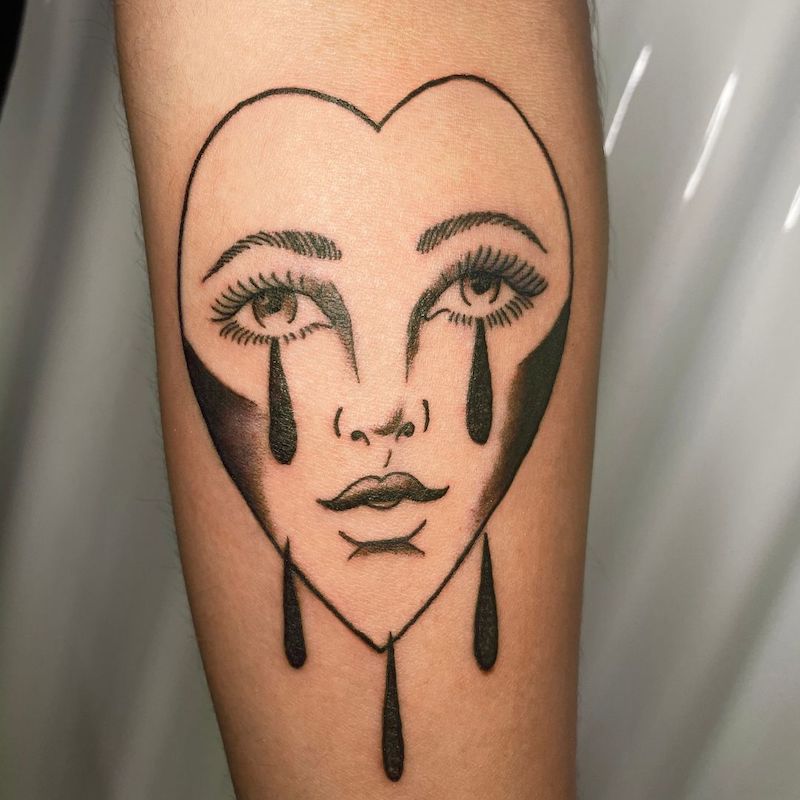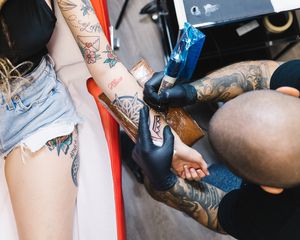
Sure, the phrase “nothing lasts forever” tends to ring true in most cases, but with a few notable exceptions. These include, but are not limited to a sturdy cast-iron skillet, unresolved feelings for a situationship that fizzled out, and the dolphin tattoo you got on spring break years ago—at least, until now. In lieu of permanent-until-lasered-off ink, Ephemeral Tattoo is changing the tattoo landscape with made-to-fade designs that last anywhere between a year and 15 months. Don’t confuse the method with the flash stickers that frequented Coachella festival grounds in years past—Ephemeral tattoos are applied using a needle and tattoo machine in the same way their traditional counterpart would be, but as the name suggests, last a moment rather than a lifetime.
To tell us all about how Ephemeral tattoos work, how they’re different from their permanent counterparts, and how to ensure your Ephemeral design fades gracefully, we spoke to co-founder Josh Sakhai and tattoo artist Marissa Boulay. Keep reading to find out if an Ephemeral tattoo is right for you.
What Is an Ephemeral Tattoo?
An Ephemeral tattoo is a tattoo that uses a special kind of biodegradable ink designed to fade gracefully over the course of a year. “The idea for Ephemeral came up from a shared experience between me and my co-founders,” Sakhai says. “We’re all from immigrant or first-gen households that hold onto a lot of culture, tradition, and values, which are all good things but can be very limiting, especially when it comes to tattoos.”
After one of Sakhai’s co-founders had a bad experience getting a tattoo removed, he posed the question: If there isn’t a way to effectively remove a tattoo, why can’t there be one that’s made to fade? And with that, the idea for Ephemeral was born. After six years and over 50 different formulations of ink (all of which were personally tested on Sakhai and his co-founders before the clinical trials), Ephemeral Tattoo opened its first shop in Williamsburg, Brooklyn, and has since expanded to Los Angeles. The company currently has 30 experienced tattoo artists working at the two open studios, with a San Francisco studio on the way.

Crying Heart by LA Artist Q for @ephemeraltattoo
Benefits of Getting an Ephemeral Tattoo
The clear benefit? Testing the tattoo waters with a piece of art that ultimately fades, allowing you to either return to your starting point or make it permanent if you so choose. Sakhai notes that this option is often more appealing (and less intimidating) for those who have never gotten a tattoo before. “It could be that you’re a first-timer who doesn’t know where to start in terms of finding an artist, or are intimidated by the experience of a tattoo shop,” he says.
“We also have clients who have previously gotten tattoos, but are coming in to get pieces they would not get permanently—maybe it’s in a place that’s visible, or the design in question is something that’s more of-the-moment than for life.” See also: The lower back tattoo we wanted but never got (and never got over) in the early aughts.
How to Prepare for an Ephemeral Tattoo Session
If you’ve ever gotten a traditional tattoo before, the preparation process is very similar—start by booking your appointment online and filling out a form to describe what you’d like, attaching reference photos if necessary so that your artist can come up with a custom design. “Alcohol thins the blood and can cause excess bleeding during tattooing, so we recommend that you avoid alcohol the night before,” Boulay says. “Eat something beforehand as well, especially if it’s your first tattoo so that you feel good and ready when you come in.” Additionally, opt for loose-fitting clothing to ensure you’re comfortable during the process and won’t have to struggle with getting super-tight clothing back over the fresh piece.
What to Expect During an Ephemeral Tattoo Session
Once you check in at the studio, your artist will meet you in the lobby for a consultation, at which point you can make any adjustments to the design before heading to the semi-private station to place the stencil. “One big point of feedback we got was that, a lot of the time in a traditional shop setting, you’re kind of exposed if you’re getting tattooed in a vulnerable area, so when we were designing the Ephemeral shops, we wanted to ensure our clients get a semi-private experience,” Sakhai says. “You’ll still feel like you’re in a tattoo shop, but are protected and safe.”

Your artist will clean and shave the area where the tattoo is being placed, and once you approve the placement, they’ll get to work with the tattoo machine and needle to create your design. Keep in mind the delivery method is the same as a traditional tattoo, so it’s very much going to feel like you’re getting a tattoo, and certain areas may be more sensitive than others. Still, the feeling is far from brutal—as someone who has gotten a few traditional tattoos, I’d describe it as a slight pricking sensation, or similar to scratching a sunburn. Once you’re finished, your artist will cover the design in a hydrocolloid patch, take you through the aftercare process via a comprehensive presentation, provide contact info for if you have additional questions, and send you on your way with your own aftercare kit.
Aftercare
A member of Ephemeral’s customer experience team will take you through their entire aftercare presentation to ensure there isn’t any room for confusion, but generally speaking, you’ll be sent home with a hydrocolloid patch covering your tattoo, which you’ll change after a few days depending on your artist’s instructions.
- Remove the first patch when instructed, wash the tattoo with the included soap, then re-cover with a new patch for the time frame instructed by your artist. Keep in mind that some bubbling or fluid under the hydrocolloid patch is normal and part of the process.
- Once your second patch is ready to remove, you’ll wash the tattoo again to remove any ink or plasma, then moisturize using the included tattoo balm.
- Avoid sun exposure and keep moisturizing the tattoo for four to six weeks (the time it takes the tattoo to fully heal), and once it's healed, Sakhai advises applying SPF to the area daily to reduce unprotected sun exposure.
- Itching, peeling, and irritation is a typical reaction as your tattoo heals, so make sure you don’t scratch at the area or pick at any of the flaky areas before they’re ready to fall off on their own.
According to Sakhai, aftercare for your Ephemeral tattoo is especially important to ensure your tattoo stays in its optimal state, even as it fades over the course of a year. “Before launching, we did a lot of research and studies into aftercare, so even though we’re sending our clients home with an unscented soap and ointment, we’ve tested a lot of different options to pinpoint the best formulas for Ephemeral tattoos in particular,” he says.
Before and After

Ephemeral Tattoo
Your tattoo will be at its most vibrant point once it fully heals, and in the months that follow, will gradually fade and become less intense as it ages. The picture above shows an Ephemeral tattoo both fresh and at nine months after application—on the right, you can see the design is well on its way to disappearing as intended. Both Boulay and Sakhai sing the praises of keeping your tattoo hydrated with a layer of sunscreen to ensure the design continues to look good as the piece disappears and your skin returns to its original state.
Ephemeral Tattoos vs. Traditional Tattoos
While the delivery of the Ephemeral tattoo is the same as that of a traditional tattoo, the difference lies in the ink developed by Ephemeral for use in their studios. “Permanent tattoos are permanent because when the ink particles are placed into your skin, they clump together and form large blocks of ink that are too big for your body to remove, so they stay that way forever,” Sakhai explains.
“Our ink does something quite similar—we have particles that go into the dermal layer of the skin that also clump together, but the difference is that ours is biodegradable, so the ink itself breaks down over the course of a year, forming smaller and smaller clumps that your body is able to naturally remove.” By contrast, if you want to get rid of a traditional tattoo, the process requires multiple laser removal treatments, with seven to 10 sessions needed on average and issues like blistering or irritation generally being common.

Shh Lady by NYC Artist Gusti for @ephemeraltattoo
Of course, the fading process of an Ephemeral tattoo can be a bummer if you like the design. Keep in mind that your tattoo will gradually look more dull and less defined as you’re approaching the one-year mark. Boulay also notes that areas like your hands, feet, and joints—even with traditional tattoo ink—are more prone to fading and aren’t highly recommended for an Ephemeral piece.
“Even with permanent ink, tattoos in those areas tend to fade a lot faster than other areas of your body because of constant use,” she says. “We tend to avoid areas where we feel it will be a challenge for healing and fading, but because we’re always making improvements, I’m optimistic that it won’t be forever.” Additionally, Ephemeral tattoos are currently only available in black ink, so unfortunately any design ideas that require color will have to wait.
Potential Side Effects
Scarring in the treated area as well as hypo/hyperpigmentation are common side effects of an Ephemeral tattoo, just as with traditional tattoos. “Any time there’s a needle going into your skin, or you get a cut or abrasion, your skin has to heal, and when that happens, there’s a risk of a scar and that the pigmentation of the skin might be lighter or darker that the skin around it,” Sakhai says.
“Our artists are always mindful about working with the skin in a way that sets it up for success in the long run, but like with any tattoo process, there is a chance that there might be some hypo- or hyperpigmentation after the tattoo goes away.” He notes that the discoloration does tend to fade, but the possibility can never 100% be ruled out, as everyone heals differently.
The Cost
Ephemeral places most of their tattoos into two categories: subtle or statement. “Subtle tattoos consist of linework or script, and will run between $195 to $245,” Boulay says. “Statement tattoos are between $350 and $550, and those would be larger, more detailed pieces that require a lot of depth and shading. If you want to adjust the pricing when you’re in the studio, we can always accommodate.”
At the time of the booking, Ephemeral’s customer experience team will provide a rough estimate of what you’d pay, and the final price will be determined after the consultation (but before the needle touches your skin) to account for any last-minute edits or additions to the piece. Sakhai notes that tips and the cost of the aftercare kit are also factored into the final sticker price to streamline the process for the client.
The Takeaway
If you’ve ever uttered the phrase “I want a tattoo, but I can’t think of anything I’d want on my body forever,” then an Ephemeral tattoo could be the perfect starting point for you. The Ephemeral team has put so much thought into the entire process—from the point that you request a design, all the way until you leave with your aftercare set in hand—keeping the comfort of the client top of mind. While the tattoo may have a lifespan of a year, the memory of how you were treated during your visit is one that sticks with you, particularly if it’s your first time testing the tattoo waters.
Boulay notes that it’s a great place for an artist to be, too. Ephemeral is one of the first studios to give each artist benefits, healthcare, a guaranteed salary, and equity in the brand. “I’ve been tattooing for 11 years and have worked in so many tattoo studios, but this is one of the first studios where I feel like I’ve made real friends and real relationships” she says.
“I really do think the experience at Ephemeral is a lot more intimate and personal, and there’s a real community feeling among the artists.” That, of course, is translated in the team’s interactions and experiences with the clients, which are often so positive, the client in question ends up wanting their Ephemeral tattoo to eventually become a permanent one. “It happens a lot!” Boulay adds.
“Sometimes we’ll be in the middle of a tattoo, and they’ll be like, ‘I like it so much, and I think I already want it forever.’” While there aren’t plans to incorporate permanent tattoos, the studios remain a creative playground for both clients and artists alike, bringing tattoo newbies and enthusiasts alike access to customized designs, celebrating the beauty of change, and keeping in mind that everything is ephemeral—not unlike the delicate lavender sprig adorning your forearm after your first (but certainly not last) visit.

















